
On this page you will find a description of the imagery on the West Face and the East Face of the Scripture Cross at Clonmacnois. Following this is a brief description of the Site and its History.
The Cross
The Scripture Cross at Clonmacnois is one of the outstanding Irish High crosses. It was carved and erected by Abbot Colman in honor of King Flann, who died in 914 CE. We know this from an inscription on the cross itself. The Scripture Cross is a prime example of a genre of crosses that depict biblical scenes, the scripture crosses.
In the photo above we are looking east and see the cathedral in the background. Begun in 909, the ruins are mostly 12th century.
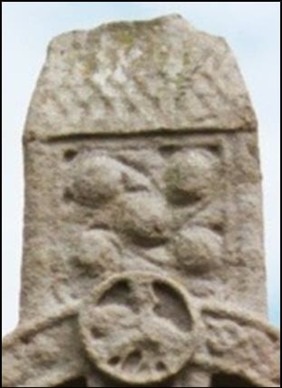
West Face
The top or cap of the cross [to the right] is in the shape of a gable roof with shingles. This is one of the common conventions used for the tops of the Irish High Crosses.
In the panel below the cap, are five interlinked bosses. The curving lines that connect them are typical of what is known as Insular Art, the early art of what is often referred to as the British Isles.

Moving down the cross face and focusing on the ring of the cross [to the left] we see it has roundels at 3, 6, 9 and 12 o’clock. The carving on the roundel at 12 o’clock appears to be a horseman.. The significance of this symbol is not known. That at 6 o’clock can be interpreted as a descending dove. Here the symbolism is probably of the Holy Spirit. Its placement below Jesus it could represent his descent into Hell following his death (one possible interpretation of Ephesians 4:9-10.)
In the ring, lower left and upper right we have animal interlace, though it is difficult to decipher in this photo. Upper left and lower right we have bosses linked in S-shapes which tie in with the upper panel above.
The center of the cross head features the crucifixion of Jesus. Peter Harbison writes “Christ, represented as if wearing a short trouser-like garment and with his legs bound, is shown with his outstretched arms falling at an angle and with his large hands bearing the nail heads in the centre of the palms.” (Harbison 1992, 52)
There are other interesting features in this scene. The figures to the left and right of Jesus are traditionally identified as Stephaton (left), who offers Jesus vinegar on a pole and Longinus (right) who stabs Jesus with a lance. Stephaton and Longinus appear in the passion story in the Gospel of John 19:28-34.
There is also a small figure just above Jesus’ head. It is often identified as an angel. It probably symbolizes the presence of God with Jesus as he suffers on the cross.
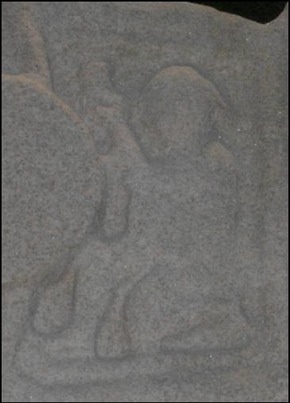
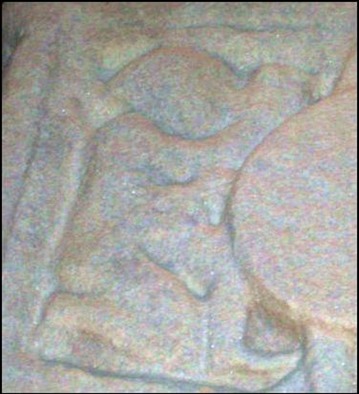
On each arm of the cross [see photos above] a figure kneels, holding an object. The objects are identified as symbols of the Sun or Ocean on the left or north and the Moon or Earth on the south or right. According to Peter Harbison, during the first millennium, these were symbols used frequently in depictions of the crucifixion . (Harbison 1992, 52)
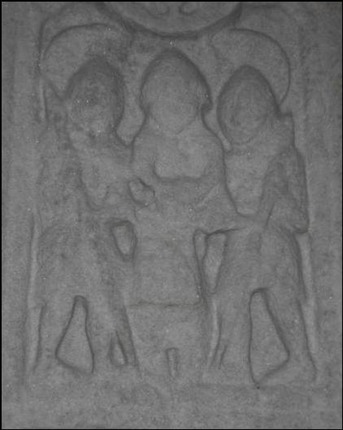
We now move to the shaft of the cross. Scholars differ on the interpretation of the top scene [to the right]. The key issue is the identification of the center figure. If understood as Jesus, the scene might be Christ on the way to the cross, his arrest, mocking, betrayal or flagellation.
Peter Harbison identifies all three figures as soldiers. Those on the right and left hold spears. The center figure seems to hold a shirt-and a knife. Based on this Harbison interprets the scene as the soldiers preparing to divide Jesus’ garments as in Matthew 27:35. In this act the artist may be referring the viewer to Psalm 22:18 where the belongings of a man desperately ill are already being divided by those around him. (Harbison 1992, 51)
This panel reminds us of the difficulty of interpretation of the biblical scenes on the crosses. Some are very clear while others are more obtuse.
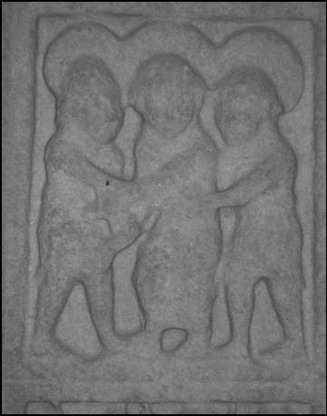
Moving down the shaft, this scene is generally recognized as either the arrest or flagellation of Jesus. Two soldiers are seen to hold Jesus. As in the previous scene, the apparent halos on the two flanking soldiers are interpreted as helmets, though the halo above Jesus’ head is identical and interpreted as a halo.
While the carving of the panel has been worn by wind and water Peter Harbison is able to identify a rod-like instrument in the right hand of the left soldier. This leads him to identify this as the flagellation or beating of Jesus rather than the arrest. (Harbison 1992, 51.)
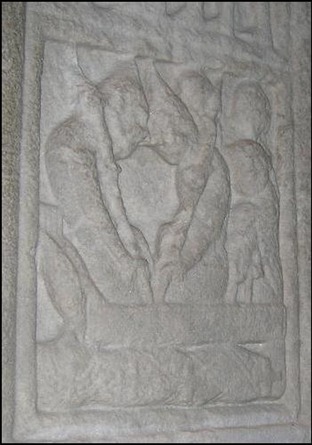
At the bottom of the shaft we have this scene [to the right] that represents the burial and impending resurrection of Jesus as recorded in Matthew 27:57-28:5. The scene depicts dynamic action. Jesus body is in the tomb. The two guards are leaning together “like dead men.” In the upper right we see the faces of “Mary Magdalene and the other Mary.” The angel appears center right. The small figure in the fold of the angel’s wing may, according to Peter Harbison represent Adam. This is most likely if Jesus’ decent into Hell is part of the testimony of this side of the cross. (Harbison 1992, 51)
Most interestingly, there is a bird just above Jesus’ head lower left. It appears to have its beak in Jesus mouth. This could represent the Holy Spirit about to breath life back into Jesus. What we see here may represent the last moment before the resurrection.
East Face
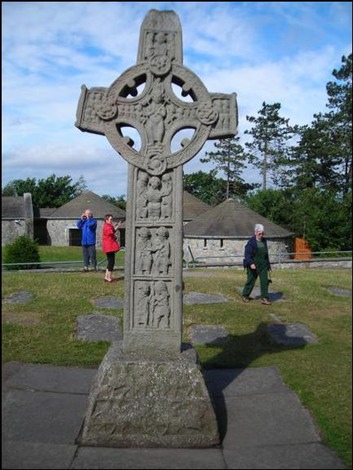
In the photo to the left, we are looking west toward the modern visitor center and museum. The originals of the Clonmacnois High Crosses are located there. The cross in the photo is a replica placed in the location of the original. The photos below, with one obvious exception, were taken of the original cross.
Having a High Cross of quality was a clear sign of the wealth of a monastery. The creation of these crosses in the early years may have been in response to Viking raids. While smaller silver or gold crosses and other fixtures were easily removed, the High Crosses had no value to the Vikings and were not easily movable at any rate.
Clonmacnois was plundered five times in the 9th century, once by the King of Cashel. During the 10th century the monastery was plundered at least nine more times. (MacGowan, 7-9) Given this history it is amazing that the two primary High Crosses were not damaged and that the monastery continued to flourish for 1000 years.
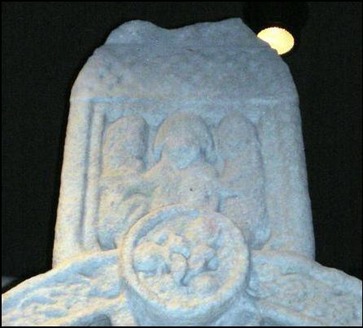
Scholars do not all agree on the identification of the scene at the top of the east face of the cross.
Harbison identifies it as the Majestas Domini or the Majesty of the Lord. He identifies the central figure as Christ and the two flanking figures as angels. While not evident in this photo, Christ is holding a book. (Harbison 1992, 49)
Veelenturf tells us that the Majestas Domini image, is absent from the Irish High Crosses. Missing from the Scripture Cross image are the technical characteristics of Christ offering a blessing and Christ surrounded by four beings symbolizing the four Evangelists: Matthew as a man, Mark a lion, Luke a calf and John an eagle. (Veelenturf, 32, 68)
In either event, Christ and the Gospels are represented in the image [above], perhaps Christ as Risen Lord.
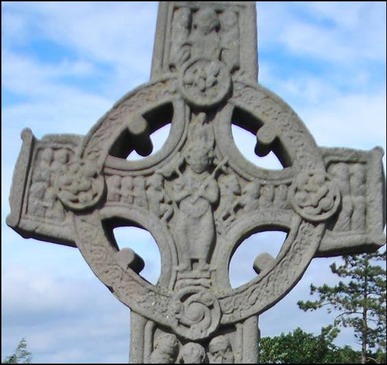
The center of the head of the cross and the arms form one integrated scene. This is clearly the Last Judgment. Harbison writes: “Christ stands . . . carrying a scepter . . . over his right shoulder and a cross-staff over his left shoulder. To the left is a figure . . . playing a flute, behind which . . . are the righteous turning toward Christ. To the right of Christ . . . is a figure with its back to Christ and holding what may be a three-pronged fork over the right shoulder, driving further to the right the wicked who have turned their backs on Christ on their way to eternal damnation.” (Harbison 1992, 49)
This image is a composite, not related to any specific biblical text. There may be some relation to the Judgment of the Nations in Matthew 25:31ff. Another possible connection may be with story of the Messages of the Three Angels in Revelation 14:6ff. Mostly it reflects an image the early church had come to associate with the Last Judgment.
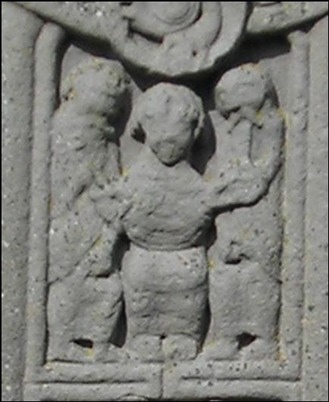
The interpretations of this scene [to the right] are varied. They include the Arrest of Jesus [Mt. 26:47f; Mk. 14:53f; Lk. 22:66f; Jn 18:12f], the Mission to the Apostles [Mt. 10:1f; Mk. 6:6f; Lk. 9:1f], and the story of the Loaves and Fishes [Mt. 14:13f; Mk. 6:30f; Lk. 9:10f; Jn. 6:1f].
From time to time a scene on a Scripture Cross will be given a contemporary (10th century) meaning. One interpretation of this scene is Odo rebuilding the church of Saint Kieran.
Harbison, who reports the interpretations above identifies this as the Traditio Clavium or Giving of the Keys. In Matthew’s version, Jesus says to Peter “I will give you the keys of the kingdom of heaven, and whatever you bind on earth will be bound in heaven, and whatever you loose on earth will be loosed in heaven.” [Mt. 16:19] He identifies the third figure as Saint John. In the scene Jesus gives him a book (the gospels). (Harbison 1992, 49)
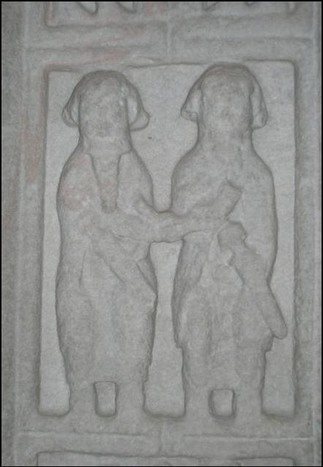
In this scene [to the left] we have two figures, both clearly secular as they wear swords. The scene has been given a variety of interpretations that reflect the history of the area from the foundation of the monastery there to the time of the erection of the cross. For example, “conclusion of a pact between Flann Sinna and Cathal mac Conchobair, king of Connacht.” (Harbison 1992, 49) Flann was high king at Tara during the time of the erection of the Scripture Cross.
Harbison offers another tentative suggestion. Keeping with the biblical nature of most of the images he suggests this is an image of the chief butler of Pharaoh offering a drinking horn to him. This would make the image a reflection on one part of the Joseph cycle in Genesis 40.(See also the next figure below.) The butler had been thrown into prison by Pharaoh. Joseph interpreted a dream the butler had and predicted his reinstatement. Three days later he was in fact reinstated. His handing Pharaoh the drinking horn signifies the fulfillment of Joseph’s prophesy. (Harbison 1992, 204) (See also Reflection on the Iconographic Program below.)
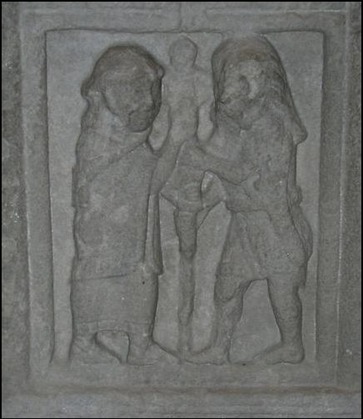
Once again, this scene has various interpretations, some contemporaneous with the cross and others biblical. Harbison sees the possibility that this scene is related to the one above it. Though there are some difficulties with the interpretation he sees this as a possible image of Joseph interpreting the dream of the butler in the text from above found in Genesis 40. The butler says to Joseph, “in my dream there was a vine before me, and on the vine there were three branches. As soon as it budded, its blossoms came out and the clusters ripened into grapes.” (Harbison 1992, 203)
An appealing contemporary interpretation sees the figures as Stain Kieran on the left and King Diarmuid founding the monastery. Diarmait mac Cerbaill was High King at Tara when Clonmacnois was founded.
Reflection on the Iconographic Program: It may be possible, in some cases, to read the images on a scripture cross as representing one iconographic whole. It has been suggested that the theme of the west face of the Scripture Cross at Clonmacnois is the Passion Week. Theologically this is the pivotal event in God’s action for salvation. We have, from top down, the crucifixion, the soldiers dividing Jesus' garments, the arrest or flagellation and at the bottom Jesus in the tomb.
It is possible to read the east face of the Scripture Cross as continuing the theme of salvation. Reading from the top down, we have the Risen Christ, the agent of salvation; Christ and the Last Judgment, with some saved and some cast out; the Church in the persons of Peter and John being given the keys to the kingdom and the gospels, the temporal power of salvation; and, seeing Joseph as prefiguring Christ, God’s historic and ongoing work for salvation. This latter is related to the Last Judgment in that while Pharaoh’s baker is not shown in the lower two panels, those knowing the story would know that while the cup-bearer was restored, the baker was beheaded. In addition, both panels have to do with the events that led to the release of Joseph from prison and his eventual rise to power in Egypt under Pharaoh. It is significant that Joseph’s interpretation of the butler’s dream was fulfilled on the third day, even as Jesus was raised on the third day.
The Site
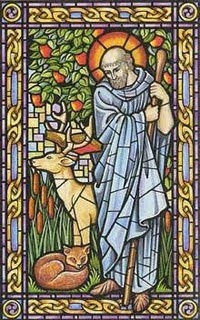
The Founder: Clonmacnoise was founded by Saint Ciaran, surnamed Mac an Tsair, or "Son of the Carpenter". Ciaran was born at Fuerty, County Roscommon, in 512, and in his early years was committed to the care of a deacon named Justus, who had baptized him, and from whose hands he passed to the school of St. Finnian at Clonard . Here he met all those saintly youths who with himself were afterwards known as the "Twelve Apostles of Erin", and he quickly won their esteem. (newadvent.org; Abbey and School of Clonmacnoise) Photo to the right 2/6/2013 from http://celticvoices.blogspot.com/2010/09/st-ciaran-of-clonmacnoise-sept-9.html
After leaving Clonard, Ciaran, like most of the contemporary Irish saints, went to Aran to commune with holy Enda. (newadvent.org; Abbey and School of Clonmacnoise) “Hagiographic accounts suggest specifically that the monastic settlement at Clonmacnoise was inspired by a vision which Saint Ciarán shared with Enda . . . This vision was of a great fruitful tree, beside a stream, in the middle of Ireland protecting the island. Its fruit went forth over the sea that surrounded the island, and the birds of the world came to carry off some of that fruit. Enda advised him that Ciarán was that tree: ‘for thou art great in the eyes of God and men, and all Ireland will be full of thy honour. This island will be protected under the shadow of thy favour, and multitudes will be satisfied with the grace of thy fasting and prayer. Go then, with God’s word, to a bank of a stream, and there found a church’”. (Management Plan p. 57) When Ciaran arrived at Clonmacnoise he was accompanied by seven followers. Only seven months after his arrival, Ciaran died and was succeeded as Abbot by Oenna, one of those followers. (MacGowan, p. 7)
Like many other saints, Ciaran was reported to have a special love for animals. When he went to Clonard to study with St. Finnian, “he took a dun cow and her calf. The cow provided milk for the community. (Earle & Maddox p. 118)
Sources: Textual information about Clonmacnoise comes from the Irish Chronicles and from the Saints Lives. Because the chronicles are generally accepted as reliable only from the late 6th century, the exact date of the founding of Clonmacnoise is uncertain. In all probability Ciaran founded his monastery between 544 and 548 CE.
Location: The selection of the site for Clonmacnoise contributed to its success. Clonmacnoise was built at the strategic intersection of the River Shannon and the Sli Mhor (Great Road). The River Shannon is the longest river in Ireland and runs north/south. The Sli Mhor is an esker that crosses the Irish midlands east/west. An esker is a long narrow ridge composed of sediment laid down by a glacial tunnel. Around the site, making it almost an island are the Shannon Callows (a river meadow submerged during flooding), the Mongan Bog and the River Shannon. It was also sited on the boundary between the kingdoms of Connacht and Mide or Meath.
Layout of the Site: In addition to the importance of the location of Clonmacnoise, the layout of the site as it developed over time has symbolic importance. Archeological surveys have identified three concentric enclosures at Clonmacnoise. “The symbolic significance of this layout is explained in the early eighth-century Collectio Canonum Hibernensis:
‘There ought to be two or three termini around a holy place: the first in which we allow no one at all to enter except priests, because laymen do not come near it, nor women unless they are clerics; the second, into the streets the crowds of common people, not much given to wickedness, we allow to enter; the third, in which men who have been guilty of homicide, adulterers and prostitutes, with permission and according to custom, we do not prevent form going within. Whence they are called, the first sanctissimus, the second sanctior, the third sanctus, bearing honour according to their differences’ ” (Management Plan p. 14)
The photo below shows the present buildings that are within the sanctissimus. (Photo from http://www.planetware.com/map/clonmacnoise-map-irl-clonmac.htm)
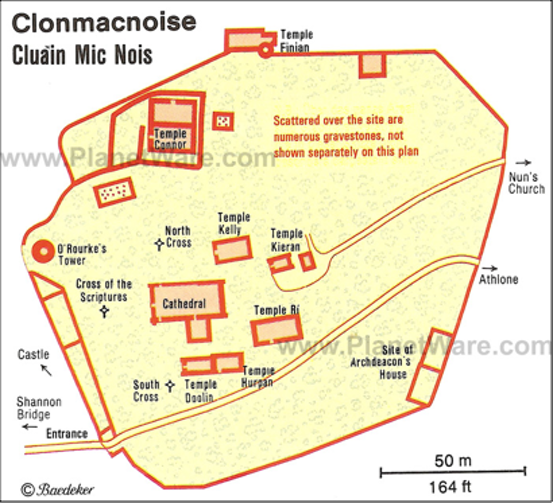
The arial photo below puts the image above in context. (Photo from http://sobreirlanda.com/2009/06/03/clonmacnoise-los-inicios-del-cristianismo-en-irlanda/)
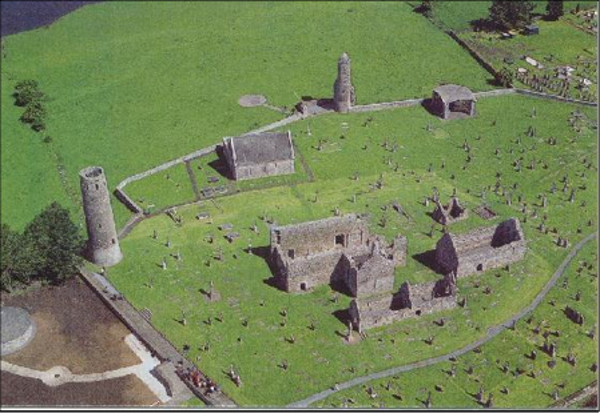
The Wooden Bridge: The inhabitants of Clonmacnoise not only built a monastic city, they also constructed a wooden bridge across the River Shannon. This bridge, downstream of the Old Graveyard has been dated to c. 804. It is the oldest known bridge in Ireland. Its span was at least 120 m and it may have stood to a height of 10-13 m. (Management Plan p. 16)
Occupation History: Archeological research has identified three principal phases of occupation. “The uppermost strata, largely disturbed by post-medieval agriculture, are of the late 11th and 12th centuries and are characterised by flagged and cobbled areas, pits, wellshafts and postholes. Below this level is the main occupation phase, dating to the 9th/10th century, with a series of houses and other structures. There is also an earlier phase dating to the 7th/8th century with stake-holes and spreads of burnt soil which indicate quite extensive occupation across the site by the late 8th century. Post-excavation work in ongoing, but it is clear that a period of great expansion occurred in the 7th/8th century with a further reorganisation and new features suggestive of urbanization appearing in the 9th century. (Management Plan p. 18)
Clonmacnoise benefited from royal patronage. This resulted in large grants of land and support for artistic endeavours such as the carving of the High Crosses of Clonmacnoise. Indeed as the wealth, influence and population of Clonmacnoise increased, there is evidence for a wide range of craft activities including work in iron, bone, stone, bronze/copper-alloy, glass, silver and possibly gold. The area was conducive to farming and there is also ample evidence for cereal production. (Management Plan p. 61)
In the early centuries all buildings were constructed of wood or wattle. The earliest of the present stone buildings Temple Doulin dates from the 9th century. The Cathedral dates from the 10th century though it was altered or restored numerous times. Most of the other buildings were built in the 11th and 12th centuries. The three High Crosses are relatively early. The South Cross dates from the 8th century; the North Cross from the 9th and the Cross of the Scriptures from the early 10th.
“In the later ninth and early tenth centuries, the patronage of the Clann Cholmáin of Mide, first under Mael Schnaill, and then under his son, Flann Sinna saw not just the renewal of the monastic core of monumental buildings in stone, with the erection of the stone crosses, but also a burst of chronicling and learned activity in the scriptorium." (Management Plan p. 61)
“The twelfth century is sometimes portrayed as one of decline for Clonmacnoise, but although the arrival of the Anglo-Normans was to prove disastrous, the material evidence of flourishing Romanesque construction suggests, prior to the invasion, an optimistic, well-endowed foundation, benefiting from Connact and Mide patronage. The round tower was built in 1124 from locally quarried limestone sourced from the Rocks of Clorhane, while in 1167 the Nuns' Church, a key example of the Hiberno-Romanesque style was completed." (Management Plan p. 63)
Following the arrival of the Anglo-Normans and church reform that followed, Clonmacnoise became less significant. It was made the see of a bishop, but of a small and poor see. The population center moved north to Athlone, a less difficult crossing point on the River Shannon. (Management Plan p. 63)
Resources Cited:
Earle, Mary & Maddox, Sylvia, Holy Companions: Spiritual Practices from the Celtic Saints, Morehouse Publishing, London, 2004.
Harbison, Peter; The High Crosses of Ireland: An Iconographical and Photographic Survey, Dr. Rudolf Habelt GMBH, Bonn, 1992. Volume 1
MacGowan, Kenneth, Clonmacnois, KAMAC Publications, Dublin 1998.
The Monastic City of Clonmacnoise and its Cultural Landscape, Management Plan 2009-2014, prepared by The Office of Public Works and Environment, Heritage and Local Government, 2009.
newadvent.org; Abbey and School of Clonmacnoise; Catholic Encyclopedia.
Veelenturf, Kees, 1997. Dia Bratha: Eschatological Theophanies and Irish High Crosses, Stichting Amsterdamse Historische Reeks.